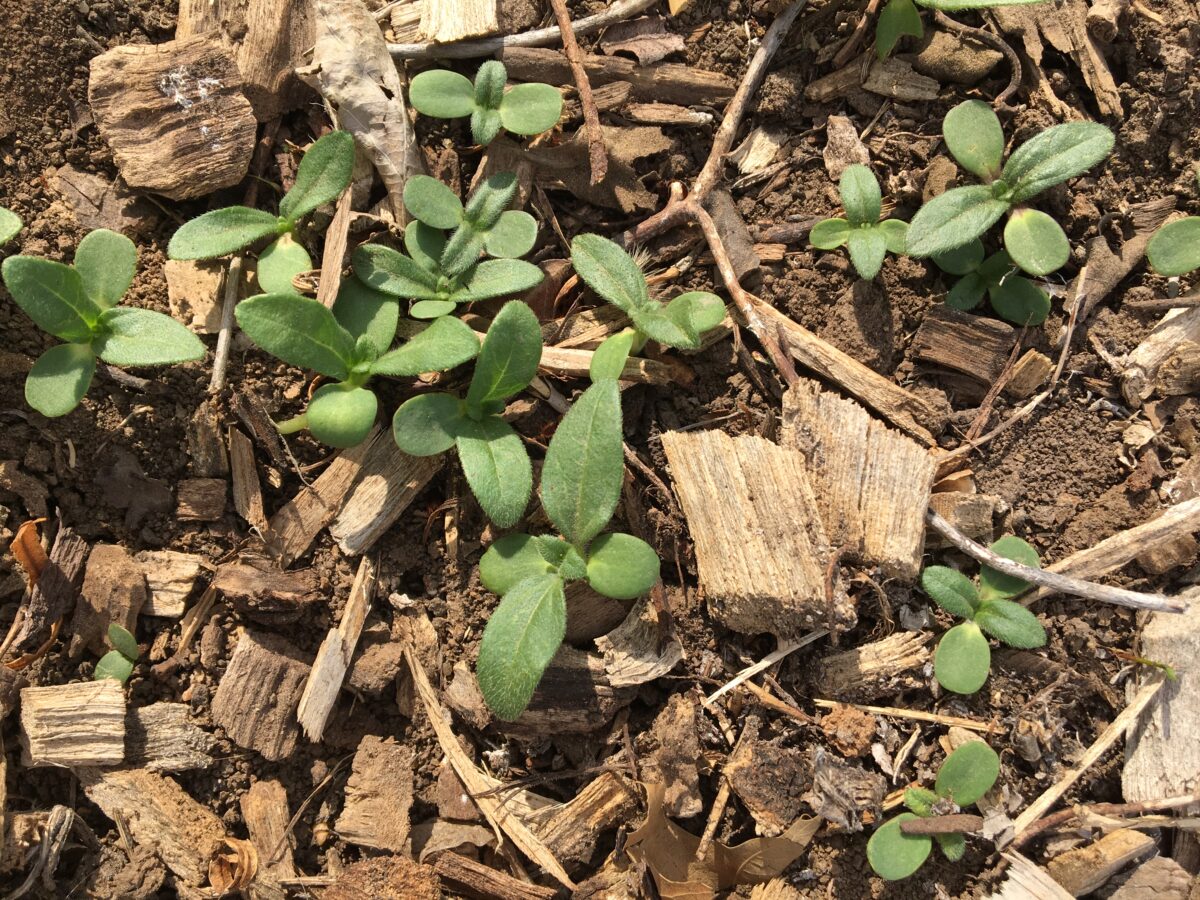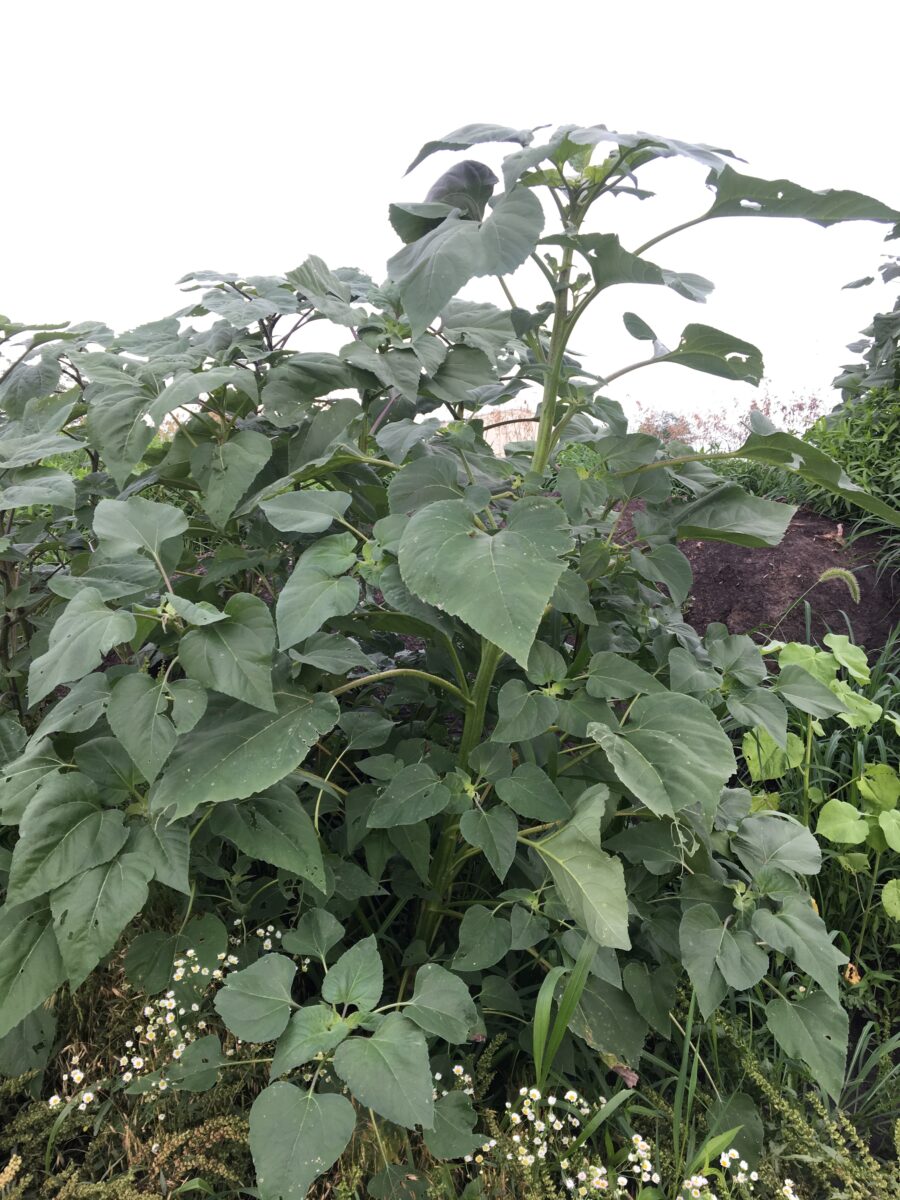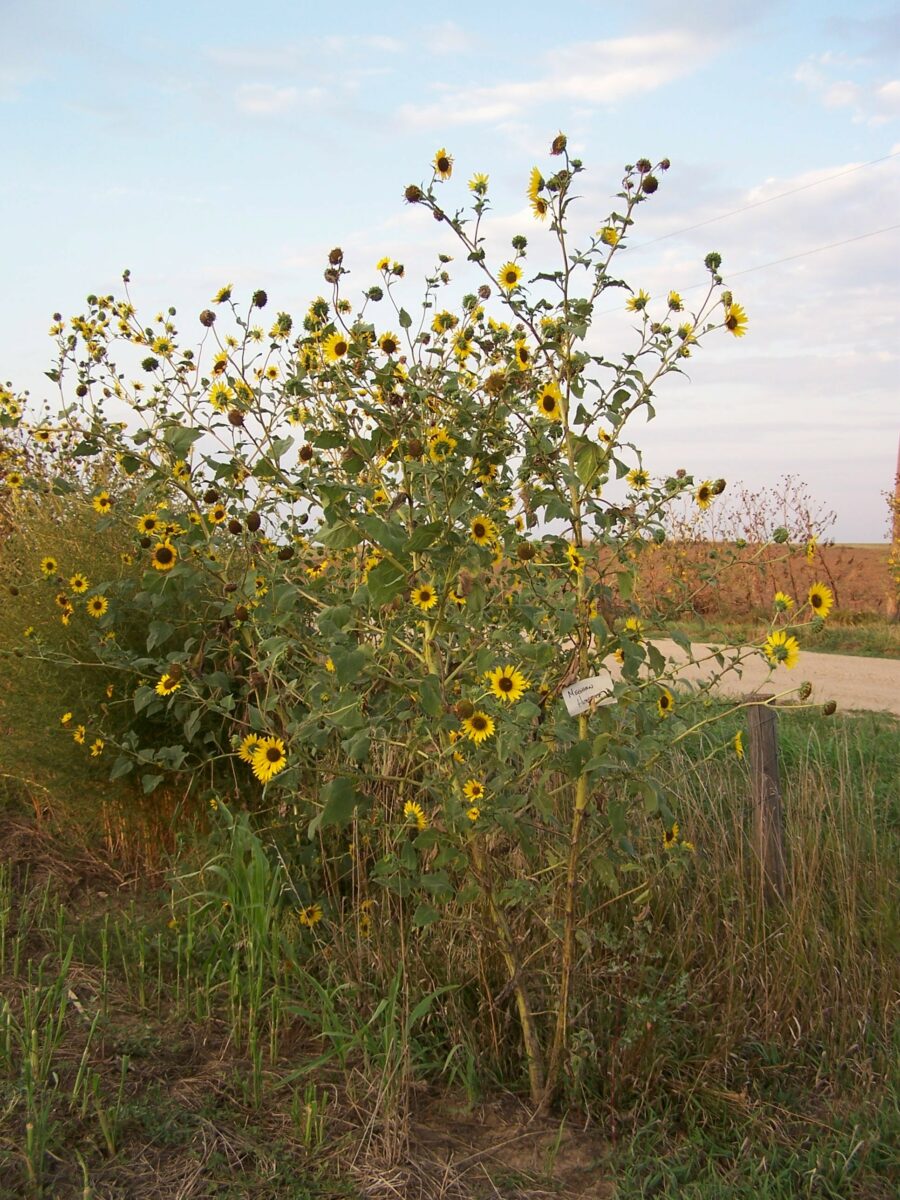Other common names: sunflower, wild sunflower



Helianthus annuus L.
Identification of Sunflower
Family: Aster family, Asteraceae
Habit: Tall, upright, branched summer annual herb
Taxonomic note: The species Helianthus annuus has been classified into a cultivated subspecies (ssp. macrocarpus), a wild subspecies (ssp. lenticularis) and a weedy subspecies (ssp. annuus). Since weedy populations are often more genetically related to nearby wild populations than to each other, the validity of the weedy forms as a taxonomic entity is in doubt.
Description: Seedling stems below the cotyledons are green to purplish. Cotyledons are oblong, hairless, 0.5–1.5 inch long by 0.25–0.5 inch wide and fused at the base. The first one to three pairs of true leaves are opposite, and all subsequent leaves are alternate. Early leaves are dull green above, light green below, toothed on edges and coated with rough, stiff hairs on both surfaces. Leaves are oval to lanceolate with a tapered and rounded tip. Mature plants are typically 2–10 feet tall. The stems are erect, branch occasionally towards the top and are densely covered in coarse, spreading white hairs. The leaves are 4–12 inches long, egg shaped to triangular or heart shaped, stalked, toothed and conspicuously three-veined. Both surfaces of the leaves are covered with stiff white hairs. Upper leaves have shorter stalks than lower leaves and may be lanceolate. The root system is a taproot with branching and spreading fibrous roots. One to 12 flower heads occur at the end of stems and branches. The flower heads are long stalked, 3–15 inches wide and consist of 20–40 yellow petal-like ray flowers surrounding numerous red- to purple-brown disk flowers. The yellow ray flowers are 0.6–1.6 inches long, whereas the disk flowers are 0.2–0.3 inch long. Beneath the flower head are two to three rows of overlapping, hairy, green, tapered oval bracts. Seeds are encased in a hard, dry fruit known as an achene. These units (hereafter called seeds) are 0.13–1 inch long by 0.1–0.6 inch wide, oval and flattened, and are tipped with two to four bracts that detach at maturity. The seeds are white, gray, brown or black, and are often mottled or streaked.
Similar species: Several species of Helianthus are similar to common sunflower. Prairie sunflower (H. petiolaris Nutt.) is an annual species with smaller, 1–2 inch-wide flowers and narrower, 2–6 inch-long by 0.5–3 inch-wide triangular to lanceolate leaves. The rhizomatous perennial Texas blueweed (H. ciliaris DC.) is shorter than common sunflower, 28 inches tall and has lanceolate, blue-green leaves. Jerusalem artichoke (H. tuberosus L.) is a rhizomatous perennial that produces knobby, irregular tubers at the rhizome tips. Jerusalem artichoke leaves are narrower, 1.6–4.7 inches wide, than common sunflower, and the flower heads are smaller, 2.5–3.5 inches across.
Management of Sunflower
Sunflower is a very early emerging spring species, so under a winter wheat crop, for example, few seedlings will successfully emerge or be a problem. The dense canopy of winter wheat and spring canola during the period when common sunflower usually emerges suppresses emergence. Also, winter grains are harvested before most common sunflower seeds are mature, so these crops will tend to reduce the population. On the other hand, in no-till summer crops, it will be up before corn, soybeans or grain sorghum are planted, so it needs to be managed at that time, or it will become a serious problem in those crops.
For bad infestations, capture the seeds in the combine and separate them from the crop afterward. Common sunflower seed has a high oil content, and captured seed could be a potential fuel source. Alternatively, the seeds can be ground to destroy viablility and fed to livestock. Grazing cattle on infested grain stubble can reduce seed production. Avoiding fall tillage is critical for managing common sunflower since incorporating seeds in soil protects them from seed predators. The relatively large, oily seeds are highly favored by quail and small mammals, and these animals frequently destroy most surface seeds over the winter. This greatly reduces the density of seedlings emerging the next spring. Although seeds can potentially survive for many years in the soil, few actually do so. Consequently, using the methods above to greatly reduce input to the seed bank for even a single year can bring a severe infestation down to manageable levels. Hand roguing escaped sunflowers is effective for preventing an increase of low level infestations in row crops.
The seedlings are large, fast growing and can emerge from deep in the soil. Consequently, rotary hoes are relatively ineffective against this weed. Tine weeding should be aimed at breaking or burying the seedlings. If common sunflower plants between rows get large, avoid using shovels on flexible S-shanks. These will tend to walk around the strong taproots and leave the plants in place. Instead, use sharp sweeps fixed at a shallow angle, and run about 1.5–2 inches deep to sever the shoot from the root. New shoots cannot sprout from root tissue alone. The large nutrient storage in the seeds allows seedlings to penetrate even thick layers of mulch.
Common sunflower hybridizes freely with the domesticated sunflower, allowing potential introduction of genes for disease and insect resistance from cultivars. This may increase survival, reproduction and competitive ability of the weed.
Ecology of Sunflower
Origin and distribution: Common sunflower is native to western North America. It now occurs throughout the United States, including Hawaii and Alaska, and in much of Canada and Mexico. It has been introduced into the Caribbean, South America the Middle East and parts of southern Asia.
Seed weight: Mean seed weights for North American populations range from 6.5–8.7 mg, although seeds produced late in the season (October) can average as little as 4.3 mg.
Dormancy and germination: Viability of common sunflower seeds is sometimes as low as 72% but can be as high as 94–99%. Seeds are dormant when mature. After a few months of dry after-ripening or overwinter burial in cold, moist soil, most seeds become capable of germination, but 26–42% may still remain dormant. Shallow burial of the seeds over the winter greatly increases germination the following spring. Some seeds will germinate at 39°F, but germination is quicker and more complete at 68–77°F. Light is not required for germination. Germination is not reduced by pH as low as 4 or as high as 10, and some seeds will germinate in water containing 10,000 parts per million salt.
Seed longevity: A few seeds survived at least 17 years when buried at 8 inches and left undisturbed. Soil burial in the autumn after seed dispersal greatly facilitates formation of a persistent seed bank. Seed mortality rates vary greatly from year to year. Average mortality rates for seeds buried for two to four years range from 26–47% per year. Mortality of seeds in the soil is low through the first winter, but most seeds on the soil surface do not survive the winter, and very few seeds persist on the soil surface for more than two years.
Season of emergence: In the northern Great Plains, seedlings emerge from late April to early June, with most emerging in May. In Kansas they emerge from late March through early May. Seeds from a Kansas population tested at sites across the Midwest showed most emergence during a roughly two-week period with peak emergence from late March to early May. The timing of emergence depended on soil temperature and moisture, and it varied substantially between years at a given site. Warmer winters prolong the period over which seedlings emerge relative to cooler winters.
Emergence depth: Seedlings can emerge from depths of at least 4 inches.
Photosynthetic pathway: C3
Sensitivity to frost: Seedlings in the cotyledon stage can survive temperatures as low as 23°F, and mature plants can survive down to 28°F.
Drought tolerance: Common sunflower is moderately drought tolerant. The main taproot can reach a depth of 10 feet, which allows established plants to extract water from deep in the soil where few other plant roots can reach.
Mycorrhiza: Wild common sunflower has high mycorrhizal infection rates. In domestic sunflower, high mycorrhizal infection improves P uptake and growth. Production of domestic sunflower can be lower following non-mycorrhizal crops such as canola, and the weed may respond similarly.
Response to fertility: USDA classifies common sunflower as having a low fertility requirement, but in Argentina it is found only on fertile soils that are high in organic matter and available phosphorus. It grows on soils with a pH between 5.5–7.8. Domesticated sunflower is highly responsive to N, with yields often continuing to increase with application rates in excess of 161 pounds per acre.
Soil physical requirements: Common sunflower can grow on soil of fine, medium and coarse textures. It can survive in poor soil, shallow soil over limestone and mild waterlogging. It has medium tolerance to salinity.
Response to shade: Common sunflower is intolerant of shade.
Sensitivity to disturbance: No information available.
Time from emergence to reproduction: Flowering begins nine to 17 weeks after emergence, and continues for four to 13 weeks, depending on the population. In the central Great Plains, common sunflower flowers from July to October, and seeds mostly disperse from September through October, though some may continue to disperse through the winter.
Pollination: Sunflowers are self-incompatible and are insect pollinated.
Reproduction: Three populations growing without crop competition averaged 38 heads per plant, 136 viable seeds per head and 5,300 seeds per plant. In another study, a typical plant growing with minimal competition produced 7,200 seeds, but some of these were immature whereas others had already shattered. An Argentine biotype grown in competition with domestic sunflower averaged 34 heads per plant, 190 seeds per head and 6,500 seeds per plant.
Dispersal: The seeds are dispersed locally by birds and small mammals. They also disperse in surface irrigation water. Combine harvesters contribute to expansion of patches of common sunflower and may also occasionally move seeds to previously un-colonized fields. The species is common along roadsides, and seeds are probably moved to new locations when soil is removed from road ditches. Seeds probably also move in soil clinging to tires and machinery.
Common natural enemies: Insects, birds and small mammals eat many sunflower seeds. In one study, 42% of seeds left on the soil surface were eaten in the first 10 days. Red sunflower seed weevil (Smicronyx fuivus), gray sunflower seed weevil (S. sordidus), sunflower moth (Homeosoma electellum), banded sunflower moth (Cochylis hospes) and sunflower budworm (Sulemia helianthana) damaged 44–58% of heads but less than 2% of seeds in some common sunflower populations in Kansas. Many of the diseases and insects of domestic sunflower probably also attack common sunflower.
Palatability: Seeds are edible for humans and livestock. Common sunflower is acceptable forage at all stages of development but should not be used as the sole feed due to a high Ca/P ratio.
Summary Table of Sunflower Characteristics
| Common groundsel | ||||||||
|---|---|---|---|---|---|---|---|---|
| Growth habit | Seed weight (mg) | Seed dormancy at shedding | Factors breaking dormancy | Optimum temperature for germination (F) | Seed mortality in untilled soil (%/year) | Seed mortality in tilled soil (%/year) | Typical emergence season | Optimum emergence depth (inches) |
| tall, branched | 4.3–8.7 | Yes | cms | 68–77 | 26–47 | – | spring | 0–4 |
| Photosynthesis type | Frost tolerance | Drought tolerance | Mycorrhiza | Response to nutrients | Emergence to flowering (weeks) | Flowering to viable seed (weeks) | Pollination | Typical & high seed production (seeds per plant) |
| C3 | high | moderate | yes | variable | 9–17 | 8 | cross | na & 5,000 |
Table Key
General: The designation “–” signifies that data is not available or the category is not applicable.
Growth habit: A two-word description; the first word indicates relative height (tall, medium, short, prostrate) and second word indicates degree of branching (erect, branching, vining).
Seed weight: Range of reported values in units of “mg per seed.”
Seed dormancy at shedding: “Yes” if most seeds are dormant when shed, “Variable” if dormancy is highly variable, “No” if most seeds are not dormant.
Factors breaking dormancy: The principle factors that are reported to break dormancy and facilitate germination. The order of listing does not imply order of importance. Abbreviations are:
scd = seed coat deterioration
cms = a period subjected to cold, moist soil conditions
wst = warm soil temperatures
li = light
at = alternating day-night temperatures
ni = nitrates
Optimum temperature range for germination: Temperature (Fahrenheit) range that provides for optimum germination of non-dormant seeds. Germination at lower percentages can occur outside of this range. The dash refers to temperature range, and the slash refers to alternating day/night temperature amplitudes.
Seed mortality in untilled soil: Range of mortality estimates (percentage of seed mortality in one year) for buried seeds in untilled soil. Values were chosen where possible for seeds placed at depths below the emergence depth for the species and left undisturbed until assessment. Mortality primarily represents seed deterioration in soil.
Seed mortality in tilled soil: Range of mortality estimates (percentage of seed mortality in one year) for seeds in tilled soil. Values were chosen for seeds placed within the tillage depth and subjected to at least annual tillage events. Seed losses are the result of dormancy-breaking cues induced by tillage, germination and deterioration of un-germinated seeds.
Typical emergence season: Time of year when most emergence occurs in the typical regions of occurrence for each weed. Some emergence may occur outside of this range.
Optimum emergence depth: Soil depths (in inches below the soil surface) from which most seedlings emerge. Lower rates of emergence usually will occur at depths just above or just below this range.
Photosynthesis type: Codes “C3” or “C4” refer to the metabolic pathway for fixing carbon dioxide during photosynthesis. Generally, C3 plants function better in cooler seasons or environments and C4 plants function better in warmer seasons or environments.
Frost tolerance: Relative tolerance of plants to freezing temperatures (high, moderate, low).
Drought tolerance: Relative tolerance of plants to drought (high, moderate, low).
Mycorrhiza: Presence of mycorrhizal fungi. “Yes” if present; “no” if documented not to be present, “unclear” if there are reports of both presence and absence; “variable” if the weed can function either with or without, depending on the soil environment.
Response to nutrients: Relative plant growth response to the nutrient content of soil, primarily N, P, K (high, moderate, low).
Emergence to flowering: Length of time (weeks) after emergence for plants to begin flowering given typical emergence in the region of occurrence. For species emerging in fall, “emergence to flowering” means time from resumption of growth in spring to first flowering.
Flowering to viable seed: Length of time (weeks) after flowering for seeds to become viable.
Pollination: “Self” refers to species that exclusively self-pollinate, “cross” refers to species that exclusively cross-pollinate, “self, can cross” refer to species that primarily self-pollinate, but also cross-pollinate at a low rate, and “both” refers to species that both self-pollinate and cross-pollinate at relatively similar rates.
Typical and high seed production potential: The first value is seed production (seeds per plant) under typical conditions with crop and weed competition. The second value, high seed production, refers to conditions of low density without crop competition. Numbers are rounded off to a magnitude that is representative of often highly variable reported values.
Further Reading
Alexander, H.M., C.L. Cummings, L. Kahn and A.A. Snow. 2001. Seed size variation and predation of seeds produced by wild and crop-wild sunflowers. American Journal of Botany 88: 623–627.
Burton, M.G., D.A. Mortensen, D.B. Marx and J.L. Lindquist. 2004. Factors affecting the realized niche of common sunflower (Helianthus annuus) in ridge-tillage corn. Weed Science 52: 779–787.
Cummings, C.L. and H.M. Alexander. 2002. Population ecology of wild sunflowers: effects of seed density and post-dispersal seed predators. Oecologia 130: 274–280.
Robinson, R.G. 1978. Control by tillage and persistence of volunteer sunflower and annual weeds. Agronomy Journal 70: 1053–1056.

